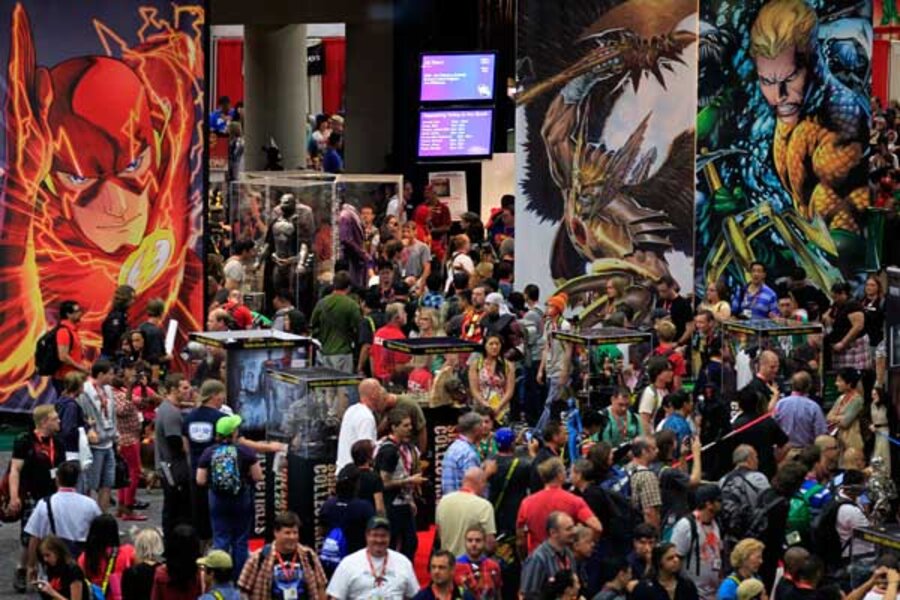How Comic-Con went from geek to Hollywood megabucks
Loading...
| Los Angeles
One of the cooler towns in the nation is bracing to be Hollywood’s hottest spot this weekend. The sea-breeze-cooled San Diego Convention Center is hosting some 125,000 fans for Comic-Con. For four days, this international convention will be the global heart of everything related to comic-book lore.
These days, however, that means much, much more than teens hauling out their cardboard boxes of vintage Superman editions and trading with a few hundred pals. In the past five years, Hollywood has moved in, transforming an insider's backwater gathering into a multimillion-dollar celebration of comic-book geek chic.
This weekend, no less entertainment luminaries than Steven Spielberg and Joss Wheedon (of "Buffy the Vampire Slayer" fame) will join a slew of other top film and TV studio executives, directors, writers, and actors to promote upcoming projects. Their incentive: free buzz from core fans.
“They are young, they are plugged in, and they know how to spread the word,” says Erik Davis, managing editor at movies.com, speaking from his cellphone as he makes his way over to the convention floor.
The convention began to draw the big studios as social media took off, he says, adding that the big movie projects typically work on a year to a year-and-a-half lead time. This year, 2012 action movies such as “The Avengers” and the latest “Spider-Man” sequel are featured films.
But, Mr. Davis points out, studios have learned a thing or two in the few years they have been courting this fan base. If an early preview sets up false expectations and the word-of-mouth turns sour, then the viral buzz can work against a big project. One of this summer’s box-office disappointments, “Green Lantern,” got a poor reception last year when early film footage was shown at Comic-Con, Davis says. That has “spooked” some studios.
Instead, he notes, the "Avengers" area is dominated by a large movie set piece, with actors in costumes – but no early footage with the potential to turn off fans. He notes that many fans had also expected director Peter Jackson to unveil early peeks at “The Hobbit.” But Wednesday, Mr. Jackson disappointed fans with the announcement that no footage would be screened.
The New Zealand director, however, had previously launched a daily web diary from the set, giving fans an up-close look behind the scenes as shooting progresses.
The Comic-Con schedule is still chock full, ranging from dozens of panels with costume designers, cinematographers, and makeup artists to the big-ticket events, such as Mr. Spielberg’s panel on his upcoming TV series, “Terra Nova.” The world premiere of “Cowboys and Aliens” will also take place at the 2,000-seat San Diego Civic Theater.
But the presence of fan panels on the schedule, such as one for “The Hobbit," is a reminder of what makes this convention different from many trade shows. “This is not for the trade, it’s for the fans,” says Jens Andersen creative director for DC Universe Online.
His team is handing out blue capes – one of the many freebies that the fans expect and happily embrace. In point of fact, this is where the still-slightly-geeky spirit of the show shines forth – costumes and characters are welcome, almost expected. And it’s clearly a family affair.
“I saw this little 4-year-old girl wearing a Mary Marvel costume,” he says with a laugh, “and she was up playing our DC Universe video game along with the rest of her family.”
While some have bemoaned the Hollywoodification of the annual event, there are still reminders of the show’s heart and soul. Over on Artist’s Alley, dozens of lower-key booths are manned by current artists – as well as those looking to cultivate the next generation.
“This is a passionate crowd, willing to do what it takes to get close to the stories and people behind them,” says Brian Bradford, director of Gnomon School of Visual Effects, who adds he hoped to find the artists of tomorrow here.
Nearby, “Sketch Theatre” hopes to show prospective animators the way. Sketch Theatre is a group that has put out a book and published a website to help encourage fresh talent. “We’re hoping to inspire and develop young artists,” says Bob Ward, creative administrator for Sketch Theatre. "You can check out your favorite artists on our website and begin the process of figuring out how to do art.”
Veteran artist Dave Dorman has attended Comic-Con for 27 years and says commercialization was inevitable. "Frankly,” he says via e-mail, “I'm surprised Hollywood waited until the last five years to discover Comic-Con. These are the rabid fans – the ones who will put their passion into saving TV shows on the brink of cancellation with write-in campaigns" and social media.
[Editor's note: The original version of the story misstated the name of "Sketch Theatre."]





